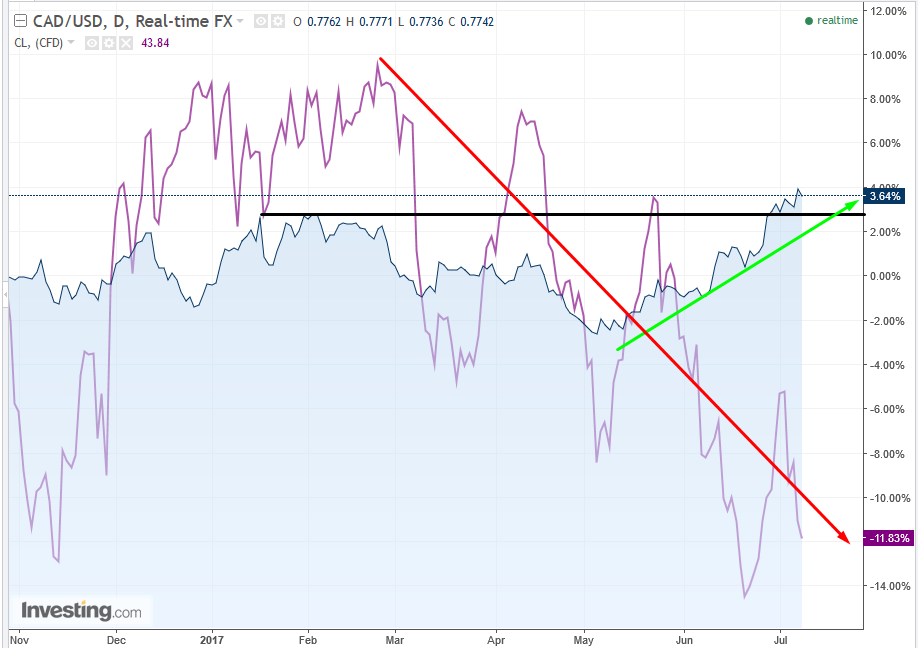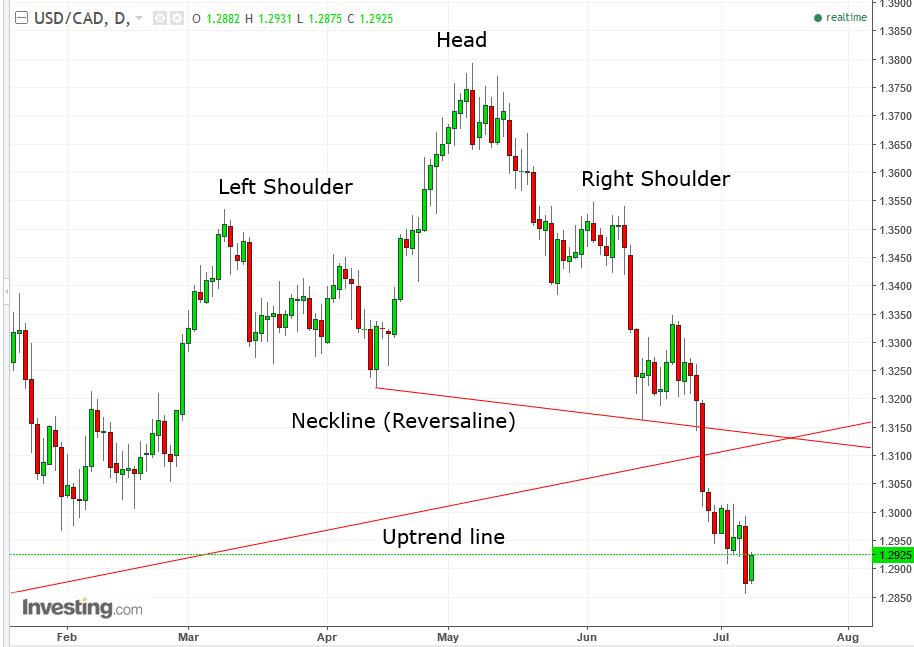by Pinchas Cohen
Some things go together so well, or at least we’re so used to them going together, that we don’t even think about it. We often grow so used to the pairing that we simply take it for granted they will always go together.
One such thing is the Canadian dollar and the price of oil. Many traders grew up on the loonie as an oil trade proxy, so much so they never question the relationship. They know the two are correlated, but they don’t actually know why.
US Oil Imports
So here it is: when the US imports Canadian oil, they first need to buy the Canadian dollar, which they use to pay for the oil. When the price of oil rises, US importers need to buy more Canadian dollars relative to their US dollars, and when the price of oil declines, US buyers need fewer Canadian dollars as measured against their American greenbacks. Since Canada is the US's closest oil exporter, making delivery cheap, most of the US's oil is purchased from Canada. Therefore, it's US oil imports and the currency needed to drive that which form the positive correlation with oil.
The Power of Shale
However, like Yoda’s immortal words, “You must unlearn what you have learned,” there is one word that destroys this positive correlation – shale. The more oil produced in the US, the less oil the US imports from Canada, decoupling the oil / loonie link.

While oil declined 23 percent from February to June, the loonie in fact climbed 0.8 percent. Compare this to the 2014 oil crash, in which the price of a barrel fell 75 percent between June 2014 and January 2016; the loonie fell 17 percent during that time.
After oil's recent roller coaster ride, it would do the loonie some good to get off at the next stop. It would provide the Canadian economy a more stable environment in which its currency would be subjected less so to the OPEC-US production race, where Canadian policy makers have no power, and more to the merits of its own economy, where policymakers can manage.
CAD’s Own Merit
Bank of Canada's Senior Deputy Governor Carolyn Wilkins told a business audience in Winnipeg on Monday that the bank is seeing the Canadian economy pick up.
Notice the next sentence: “As we move past the adjustment to lower oil prices, we are seeing the economy pick up.” Before you think that lower oil prices led to a lower CAD exchange rate, making Canadian exports more affordable, we remind you that the Canadian dollar is more expensive, after the sharp oil decline.
So, that can’t be her meaning. What, then, is the correlation between lower oil prices and an economic pick-up? Could it be stability?
Impressive Economic Gains
While the US's first quarter was the start of an argument between hopefuls and the hopeless regarding a possible US reflation, Canada posted impressive gains in its first quarter, with an annual pace of 3.7 percent – the best in the developed world – and remained steady at an annual rate of 3 percent in the second quarter.
Compare that with the US's 2.1 percent first quarter and 1.4 percent second quarter. Still, there remains room for Canada’s equity and currency growth, as Canadian investors continue to have their fingers on the panic button after the 2008 financial crisis trauma. That means Canada’s growing economy is not priced in.
To be fair, the bears have their reasons: GDP numbers fell short of expectations and concern grows over relying on the Canadian consumer’s stamina to carry the weight of economic growth. However, to put things in perspective, the global recovery – that is, everywhere – is dependent upon consumer spending. Moody’s sees the reliance upon household-related spending as an economic lack of balance, which makes it tilt toward the downside. Moody’s is also concerned over a lack of wage growth which is a recurring US problem (as recently as Friday’s NFP report), a decline in Canadian equities and currency, and a (Trump-fueled) hit to trading with the US.
However, considering the rising growth, even while Canadian stocks and its dollar have failed poorly this year – as the worst performing G10-currency against the US dollar – the economic growth, because of looming risks, has not been priced in.
Canadian Rates Are About to Go Up (90% Probable)
While Reuters economists are divided on whether the hike will happen on Wednesday, the markets are pricing in 90 percent odds of a 25-basis hike, after the Bank of Canada (like the Fed) suddenly turned hawkish last month, while a second hike is expected by the end of the year.
Canadian bond traders also seem to think it’s happening, as the 5-year yield jumped more than 50-basis points to 1.47 percent since the tone shift by the Bank of Canada last month. Also, Canada’s biggest bank, the Royal Bank Of Canada (TO:RY), has already raised rates on fixed-term mortgages, anticipating the central bank’s announcements, as they are generally based on 5-year bonds. That could be construed as a buy signal by a leading indicator.
Technical Perspective

After the loonie's 62 percent rise from the 2008 sub-parity depths to the 1.45 heights, it may just be the time for a meaningful correction. That appears to be the supply-demand balance wisdom, upon the downside breakout of a 13-month long reversal pattern, during the week before last, with a target implication of 1.2000.

Not to feel left out, the daily chart also demonstrates a reversal pattern – a smaller one within the weekly 13-month long one.
Trading Strategies
Conservative traders would probably wait on a dollar short for a return-move to retest the reversing nature of the pattern, a difficult gauge on a sloping neckline, and it could probably go as high as 1.32 on the daily chart and 1.34 on the weekly chart.
Moderate traders may wait on a dollar short for a return-move to the 1.300 congestion resistance on the daily chart and psychological round-number, while
Aggressive traders would bank on the Bank of Canada’s interest rate hike and short the dollar vs. the loonie now, while accepting a potential return move, as stated above.
Naturally, traders may combine all three risk levels into one cohesive trade strategy, while keeping an eye on the equity necessary to withstand return moves.
